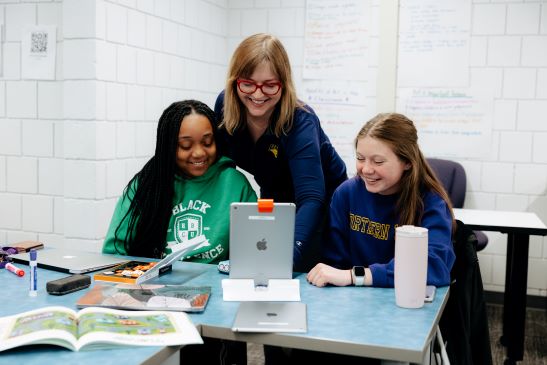Perspectives: The Changing Classroom
How Technology Transforms
By Magdalena Galloway, Associate Professor of Instruction
When our teaching university was founded in 1876, the ballpoint pen was decades away from becoming a classroom staple. Fast forward to the early 2000s, where I recall three students sharing a single desktop in a computer lab. Today, students arrive with laptops and smart devices, accessing cloud-
based content from anywhere. The computing power in our pockets now dwarfs that of entire labs just a generation ago.
Each wave of innovation has brought both excitement and anxiety. When Google launched in 1998, educators worried students would stop thinking critically. Instead, we taught them how to search smartly, with filters, Boolean logic and information literacy. Wikipedia raised similar concerns in 2005, yet it became a springboard for deeper inquiry. Now, GenAI presents the next challenge and opportunity.
As before, the goal isn’t to ban the tool, but to grow, adapt, and prepare students to share it responsibly while harnessing its power to make us better.
A legacy of innovation
 At the College of Education, we’ve long embraced innovative technology. When Iowa launched one of the nation’s first public, statewide fiber-optic systems in the 1990s, UNI took a lead role, training over 9,000 Iowans to teach and learn remotely via the Iowa Communications Network (ICN).
At the College of Education, we’ve long embraced innovative technology. When Iowa launched one of the nation’s first public, statewide fiber-optic systems in the 1990s, UNI took a lead role, training over 9,000 Iowans to teach and learn remotely via the Iowa Communications Network (ICN).
That forward-thinking continued into the 2010s. UNI was among the first adopters of Zoom for remote instruction and collaboration well before it became a household name. Our students used Docs, Sheets and Slides to create and share digital work before Google tools were mainstream. As Google’s features grew, we integrated them into our teaching.
When the COVID-19 pandemic hit, we were ready — and we accelerated. The crisis reshaped public education, highlighting the urgent need for online pedagogy and digital equity. In response, we adapted our programs to ensure future teachers could thrive in these new environments, equipped with the tools, mindset and skills to lead in digitally connected classrooms.
To support our growing online student population, we apply Quality Matters and Universal Design for Learning principles to create and model flexible, accessible courses — continuing our tradition of designing learning that meets students where they are.
Pedagogy in a digital age
When working with pre-service educators, I emphasize foundational frameworks to help guide teaching in a digital world:
- TPACK (Technological Pedagogical Content Knowledge) reminds us that effective teaching with technology is about intentional integration, balancing what we teach, how we teach and the tools we use to enhance learning.
- Connectivism sees learning as sense-making across networks of people, tools and ideas. Students learn increasingly through platforms, devices, and algorithms that influence how information is accessed and understood. As AI and personalized technologies advance, pattern recognition, linking disciplines, critical thinking and engaging diverse perspectives are essential for navigating digital spaces.
- Computational thinking is a structured way to solve problems by breaking them into smaller parts, recognizing patterns, focusing on key details and creating clear step-by-step instructions. It applies across subjects and everyday life, and also helps us understand how computers and AI systems process information.
- The 4Cs — communication, collaboration, creativity and critical thinking — are essential soft skills that help students thrive in a connected world and prepare for future careers, including ones that don’t yet exist.
A commitment to evolve
We are committed to flexible online and distance education that grows with today’s learners. Our programs, ranging from bachelor’s and master’s degrees to certificates and teaching endorsements, honor diverse goals, schedules and learning styles.
New micro-credentials include online graduate certificates that can be stacked toward a master’s degree. One focuses on AI in education — among the first courses anywhere designed to empower educators to teach about and with Generative AI.
This year, the college joined the Alliance for Innovation in Teacher Education led by the International Society for Technology in Education (iste.org). This strengthens our commitment to prepare educators and their students for the demands of the digital age. The Alliance will create richer opportunities for professional development and guide how we collaborate with peer institutions, support faculty, model best practices and integrate technology with purpose.
As we near our 150th anniversary, the commitment to evolve honors our legacy of innovation and reflects a growth mindset — welcoming change as an opportunity to learn and improve. Just as classrooms once transformed with the ballpoint pen, today we embrace the digital tide. With technology now ubiquitous, knowing how to navigate it is as vital as knowing where it’s headed.
